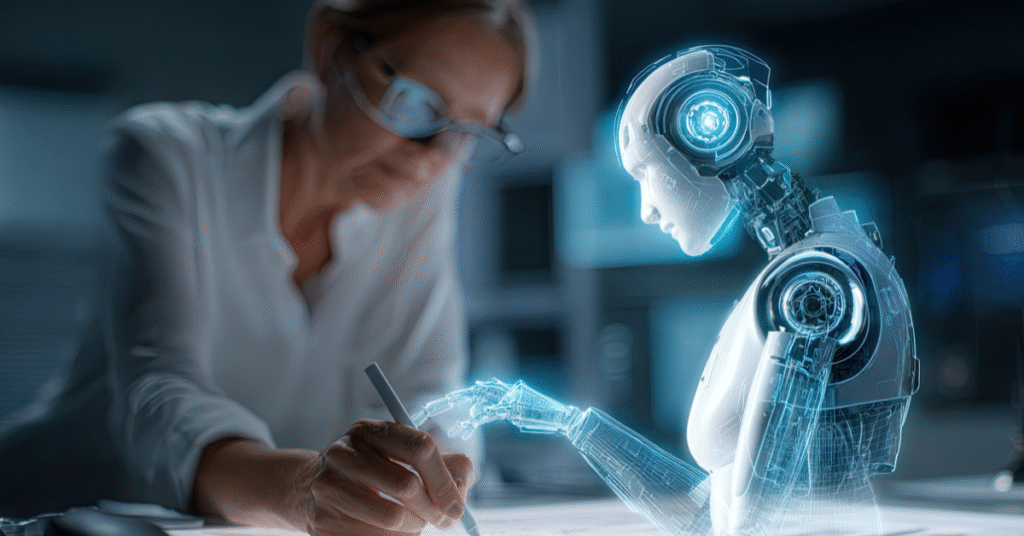Key Points:
- Introduction
- The Rise of AI in Translation
- How Human Translators Differ from AI
- Pros of AI Translators
- Cons of AI Translators
- Pros of Human Translators and Interpreters
- Cons of Human Translators
- Preparing the Next Generation of Translators in the AI Era
- Industries Most Affected by AI vs. Human Translation
Table of Contents
Introduction
In today’s fast-paced digital world, artificial intelligence is revolutionizing industries at a breathtaking speed. From virtual assistants to self-driving cars, AI has made its way into our daily lives. The rise of AI-powered translation tools like Google Translate, DeepL, and other machine-learning models has transformed how we communicate across languages.
This technological leap raises an important question: Can AI truly replace human translators and interpreters?
The debate goes beyond technology; it touches on culture, emotion, context, and the essence of human communication. While AI translation tools have grown remarkably advanced, the human translator’s deep understanding of language nuance, culture, and context remains unmatched. This blog dives into the pros and cons of AI vs. human translators, how it impacts industries like business, healthcare, and government, and what the future may look like.
The Rise of AI in Translation
AI-driven translation tools emerged to solve the growing demand for fast, low-cost multilingual communication. By using machine learning, natural language processing (NLP), and neural networks, these tools can process enormous datasets to predict accurate word choices and sentence structures.
Some of the most popular AI translation tools include:
- Google Translate
- Microsoft Translator
- DeepL
- Amazon Translate
- ChatGPT
These tools have grown from simple word-for-word translation engines to advanced systems capable of grasping basic grammar, idioms, and some contextual meanings. For businesses dealing with bulk content—like websites, product descriptions, and chatbots—AI translation offers speed and cost-effectiveness that would have been unthinkable a decade ago.
How Human Translators Differ from AI

Human translators and interpreters bring something that machines still struggle to replicate: cultural sensitivity, emotional intelligence, and contextual understanding. A human translator interprets meaning beyond the literal text—considering tone, audience, culture, and purpose. For example, translating a marketing slogan, a legal contract, or a medical record requires more than substituting words; it requires insight into culture, compliance, and subject-specific nuances. An interpreter, especially in real-time scenarios like conferences or legal proceedings, also adapts to tone, pauses, and cultural etiquette—qualities that current AI systems often fail to capture accurately.
Pros of AI Translators
AI translation has undeniable strengths that have reshaped the industry. Here are its major advantages:
- Speed and Efficiency: AI translation tools can process large volumes of text in seconds. Businesses managing e-commerce listings, customer service chats, or internal communications can scale quickly without waiting for manual.
- Cost-Effectiveness: Hiring professional translators for all content can be expensive. AI tools offer a budget-friendly solution, especially for basic translations that don’t require high precision or cultural adaptation.
- Accessibility: AI-powered translators make multilingual communication accessible to individuals and small businesses who cannot afford professional services. They also offer instant voice translations, bridging language gaps during travel or informal interactions.
- Continuous Learning: With machine learning, AI translation systems constantly improve as they process more data, leading to incremental accuracy improvements over time.
Cons of AI Translators
Despite its progress, AI still has limitations that can significantly impact translation quality and reliability.
- Lack of Cultural and Emotional Understanding: AI often struggles with idioms, humor, cultural references, and regional dialects. For example, a phrase that carries a positive tone in one culture may come across as offensive or meaningless when directly translated by AI.
- Contextual Errors: Machines still rely heavily on patterns and may misinterpret context. This is critical in fields like legal translation, medical interpretation, and technical manuals, where accuracy is non-negotiable.
- Data Privacy Concerns: When businesses upload sensitive content to online AI tools, there’s always a risk of data breaches or misuse. This is particularly risky for legal or healthcare-related translations.
- Quality Inconsistency: AI-generated translations can vary in quality depending on the language pair and complexity of the text. While some languages like Spanish and French may perform well, others with less data available often suffer.
Pros of Human Translators and Interpreters

Human translators and interpreters remain indispensable in many professional fields due to their unique strengths:
- Cultural Fluency: Humans understand cultural context, local idioms, and linguistic nuances that machines often overlook, ensuring the translation resonates with the target audience.
- Accuracy and Reliability: For sensitive industries—like law, medicine, finance, and government—accuracy is paramount. Human translators are trained to deliver precise and reliable translations without the ambiguity often caused by AI.
- Ethical and Confidential Handling: Professional translators and agencies follow strict confidentiality agreements, which is crucial when handling legal documents, corporate strategies, or medical records.
- Adaptability: Humans can adjust tone, style, and delivery to suit different purposes—marketing, technical, academic, or diplomatic—something AI cannot yet achieve seamlessly.
Cons of Human Translators
While human translation has significant advantages, it isn’t without challenges:
- Higher Cost: Hiring skilled translators and interpreters can be expensive for small businesses or startups.
- Slower Turnaround: Compared to AI’s instant processing, human translators take longer to complete large-scale projects, which may affect tight deadlines.
- Limited Availability: Finding qualified human translators for rare language pairs or highly specialized industries can be difficult.
Preparing the Next Generation of Translators in the AI Era
As artificial intelligence continues to transform the language industry, the role of human translators is evolving rather than disappearing. Future translators will need a blend of traditional linguistic expertise and modern technological skills to stay competitive. While fluency, cultural understanding, and subject-matter knowledge remain at the core, mastering AI-assisted tools will be essential for efficiency and accuracy. Educational institutions and training programs are already adapting their curricula to include machine translation post-editing, terminology management software, and real-time interpreting technology. By equipping aspiring translators and interpreters with these skills, we prepare them for a landscape where humans and machines work together. The demand for professionals who can bridge the gap between human insight and AI-driven speed will continue to grow. Those who embrace lifelong learning, specialize in niche industries such as legal or medical translation, and adapt to emerging technologies will lead the next chapter of the translation profession.
Industries Most Affected by AI vs. Human Translation
- Healthcare: Requires human oversight to avoid life-threatening errors in medical records or patient instructions.
- Legal: Human translators are vital for contracts, immigration papers, and courtroom interpreting.
- Business and Marketing: Localization experts help brands adapt messages for global markets.
- Education: AI helps with quick materials, but teachers still rely on human-reviewed translations for quality learning.
- Government and Diplomacy: Cultural sensitivity and precision make human interpreters irreplaceable in negotiations.
FAQs:
Q: Is AI translation accurate enough for professional use?
A: AI can be useful for casual communication or preliminary drafts but still requires human editing for professional accuracy.
Q: Can AI replace interpreters in live events?
A: Not entirely. AI interpreting tools lack the emotional and cultural nuance needed for high-stakes events like conferences or legal proceedings.
Q: Are human translators still relevant in the AI era?
A: Absolutely. For industries requiring precise, culturally sensitive, and ethical translation, human translators remain essential.
Q: Which is more cost-effective: AI or human translators?
A: AI is cheaper for basic tasks, but the quality and reliability of human translators often outweigh the higher cost in critical projects.
Conclusion
AI has transformed the translation industry, making multilingual communication faster and more affordable than ever before. However, human translators and interpreters continue to play an irreplaceable role in delivering context, cultural sensitivity, and accuracy—qualities machines have yet to fully master. The future of translation lies in collaboration between AI and human experts, ensuring businesses and individuals benefit from both efficiency and reliability.
Call to Action: Why Choose Translation Excellence?
At Translation Excellence, we embrace the best of both worlds—leveraging cutting-edge AI technology alongside our team of professional human translators and interpreters. Whether you need certified document translation, event interpretation, or localization for global markets, we deliver accurate, culturally nuanced solutions tailored to your needs.
Reach out to Translation Excellence today to experience translation services that combine speed, precision, and the human touch that truly connects people across languages.


